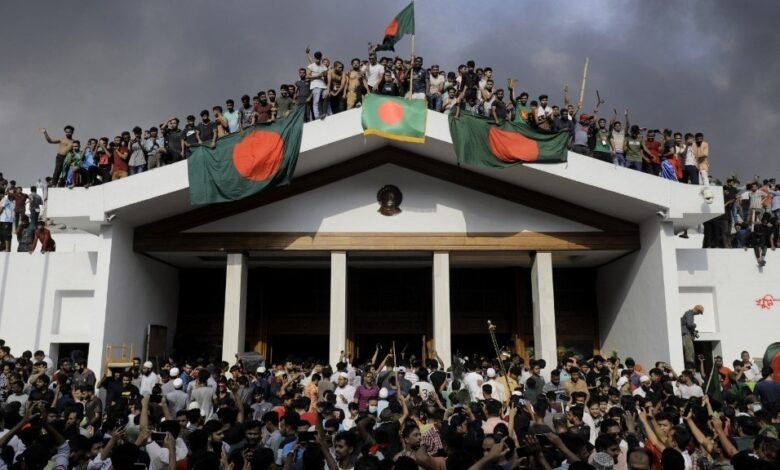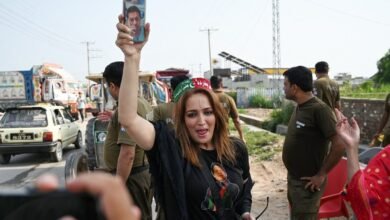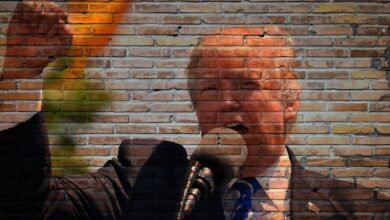Fall of Sheikh Hasina: An uprising, urban guerilla tactic or army inaction?

Fall of Sheikh Hasina: An uprising, urban guerilla tactic or army inaction?
On August 5 last year, Bangladesh Prime Minister Sheikh Hasina boarded a military helicopter in the nick of time to flee from Bangladesh as lakhs of protesters headed towards her official residence in Dhaka. Such was the haste that she couldn’t even record an address to the nation that she wanted to. But how did the regime of Hasina, who ruled with an iron fist for 15 years, crumble within weeks?
Was it more than just a student-led uprising? Did urban guerilla-style attacks aided by Hasina’s political rivals and the hands-off approach of the military play as big a role as the agitation itself in pulling down the Awami League-led government?
Bangladeshi political experts and activists in Dhaka and those in self-imposed exile describe how it was a perfect storm that combined all the above to blow away the regime that had the backing of the security and intelligence apparatus and foot soldiers of her Awami League and its student wing, the Chhatra League.
The official death toll of the mass protest, which saw security personnel opening fire on unarmed protesters and retaliatory attacks on the police, stands at 1,400. Experts suggest the toll to be much higher.
Bangladeshi-American political analyst Shafquat Rabbee says it was a “confluence of fortuitous events and conditions that all came together, ending up in a spectacular collapse for Hasina the tyrant”.
Rabbee talks about how the videos of brutal killings by the security forces got all sections of Bangladeshi society to take to the streets against Hasina.
A political commentator from Dhaka, requesting anonymity, tells India Today Digital that anti-Hasina forces had cultivated people for years within the administration. As the students-led agitation peaked, those officials stopped functioning, bringing about a total collapse of the state machinery.
Political parties like the Bangladesh Nationalist Party (BNP) and the Jamaat-e-Islami, which were suppressed by the Hasina regime, too played their part, the experts agree. The students wouldn’t have lasted even a single night without the support of the parties’ street-fighters, who have protected them with their experience of taking on the police force.
Bangladeshi political activist and writer Faham Abdus Salam says the attack on the police personnel revealed the movement had moved to the next phase, and that the Hasina government had lost its fear factor.
The last nail in the Hasina regime’s coffin was Army Chief General Waker-Uz-Zaman’s declaration that the forces wouldn’t shoot at protesters. This came as a booster shot for the crowd, which now had students, common people and members of political and Islamist outfits.
Salam also reveals that some within the military establishment harboured thoughts of preparing a guerilla force if Hasina hung on to power beyond August 5.
A year on, as the haze somewhat lifts, the July-August movement can be divided into three distinct phases, which reveal the role of the political parties and the military in the ouster of Hasina. Till now, the July-August movement was perceived as only a student-spearheaded agitation.
Here are the three turning points that unfolded in succession:
1: Anti-quota agitation by students turns into a single-point demand seeking Hasina’s resignation
2: Protest across Bangladesh after police fire at protesters, cops targeted in guerilla-style attacks
3: Army goes for a hands-off approach, with protests even at Defence Officers Housing Societies
BRUTAL KILLING VIDEOS FANNED ANTI-HASINA IRE
Sheikh Hasina returned to power for a fourth consecutive term in January 2024. The election was boycotted by the BNP, the main opposition party, and was alleged to have been extremely rigged and stage-managed.
People were tired of the corrupt regime, but enforced disappearances by the establishment forced people to stay silent. The brutal Aynaghar torture or the fear of it forced some of the best brains to flee Bangladesh. The government was seen to be working just for Hasina cronies and Awami Leaguers.
Amid this, the Bangladesh High Court’s decision in June to reinstate a quota that would reserve 30% of the civil service jobs for descendants of 1971 War veterans, seen as Hasina backers, lit the fuse.
Students took to the streets in a country where a government job is seen by millions as the only way out of poverty. The protests gained momentum in July, and Hasina’s branding the students “Razakar”, a highly despicable term in Bangladesh, acted like a catalyst. The protests spread across Bangladesh.
By mid-July, Chhatra League members, along with the police, were fighting the protesters on the streets of Dhaka. On July 16, six protesters, including 25-year-old student Abu Sayed, were killed by police firing.
“For the Hasina government, after July 17, it was all about crushing the movement. People retaliated, and then the regime started killing people indiscriminately,” says Salam, who has been living in Australia in a self-imposed exile for a decade.
The image of Abu Sayed inviting bullets with open arms went on to define the protests. Videos of brutal attacks and killings of protesters unnerved all sections of Bangladeshi society.
“Urban guerilla tactics work by creating victims, and fighting the war around them,” says the political commentator from Dhaka.
Hasina tried to buy peace by promising a probe, but the situation had spiralled out of control. On August 3, the Students Against Discrimination came out with a single-point demand — Sheikh Hasina’s resignation.
Most organic protests do not last beyond days without support from established political or civil structures. That the students-led agitation and the students themselves survived and fought for weeks pointed at the role of political parties and the military in the fall of Hasina.
MASTANS OF BNP, JAMAAT PROVIDED STREET MUSCLE
Political parties like the BNP and the Jamaat, facing political suppression, had been emaciated. Such was the situation, that the Jamaat didn’t manage to even unlock its sealed office in Dhaka over the years.
The students’ protest gave the parties the much-needed oxygen, and they used the students’ agitation to launch a full-scale attack on the Hasina apparatus.
“After July 19, police were attacked not by university students, but by BNP and Jamaat-e-Islami activists and daily-waged labourers who had joined in the protests by then,” Salam tells India Today Digital.
As evidence of that, the activist points to a video of protesters chasing away a team of security personnel in five vans, which went viral.
“You can see one person starts running at the police, and then a crowd follows him and starts chasing the cops. The person who first started chasing the cops was later identified as a BNP member. This was the case in most instances. Those leading the attacks against cops were either BNP or Jamaat members or daily-waged labourers,” says Salam.
Rabbee says among all the political parties, the BNP counts the highest number of dead activists during the July-August agitation for a reason.
“Parties like the BNP had seasoned leadership who were battle-hardened and knew how to survive and fight government machinery. The young student leaders brought political innocence into the play and attracted the masses, and the BNP and the Jamaat provided street credibility and muscle,” Rabbee tells India Today Digital.
Major political parties like the BNP also arranged physical safety and safe houses for the student leaders when they were on the run.
Salam says the Hasina government, which had dealt with online activists, was spooked by two things — shut down of remittances by Bangladeshi expats and attacks on police stations.
“People attacking the cops was an escalation that showed that the movement was in the next phase. The retaliation was evidence that the fear of the Hasina regime was gone, and it could be toppled,” explains Salam.
What goes on to show that it wasn’t the students who were mostly involved in the street warfare was that the worst violence took place after Hasina fled Bangladesh on August 5. There were political reprisal killings in which scores of Awami League and Chhatra League leaders were massacred.
“Members of Islamist organisations and Jamaat members were at the forefront when it came to attacking cops and Awami League leaders. They followed urban guerilla tactics to bring down the Hasina government, and exact revenge after that,” said the Dhaka-based commentator.
Bangladesh had descended into lawlessness and chaos for days after the fall of the Hasina regime, and the army had to step in.
BANGLADESH ARMY’S NOT TO SHOOT DECISION WAS GAMECHANGER
Waker-Uz-Zaman was appointed Bangladesh Army Chief in June 2024, when the country was already simmering.
Zaman, a relative of Hasina, operated with fairness during the entire agitation, according to multiple sources.
By then, protests had even started in Defence Officers Housing Society areas in Dhaka. This was unprecedented because military officers were pampered by Hasina and their children brought up in relative affluence.
“Hasina not only took care of the military with unprecedented largesse, but she also changed the Constitution to deter political intervention by the military, making it a crime of high treason,” says Rabbee.
The lower-rung officers and sepoys, like some of the civilian officials, had by then gone into a civil-disobedience mode. That was a result of news of young relatives falling prey to bullets, sources told India Today Digital.
On August 4, with the Hasina government finding itself embattled with millions ready for the long March to Dhaka a day later, a shoot-at-sight curfew was ordered.
Waker-Uz-Zaman, in a meeting with the top Army commanders on August 4, decided that his force would not shoot at protesters. This, and the reports of military officers unwilling to act against protesters earlier, boosted the confidence of the protesters.
Hundreds of thousands started pouring into Dhaka at daybreak on August 5. That is when General Zaman visited Hasina and asked her to board the military helicopter and save her life.
“Ultimately the military had to force her collapse, mostly because the sheer number of people on Dhaka’s streets with bricks and sticks were simply multiple folds of the count of ammunition the security establishment had at their disposal,” says Rabbee.
Not only did the army take a hands-off approach, some lower-ranking military personnel were also looking at options to bring down the regime if Hasina lasted beyond August 5.
“A military official told me he considered resigning and arming civilians for urban guerrilla warfare if Hasina had not fled on August 5,” says activist-writer Salam, adding, “This tells you this was a civil war situation.”
HASINA’S BANGLADESH EXIT NOT JUST DUE TO STUDENTS AGITATION
Though students were the ones who started the fire, but it became an inferno because political parties and Islamist organisations added their muscle to the fight.
Bodies in morgue and those injured reveal the extent to which political and religious outfits participated in the street fights.
The cheers that greeted the army and personnel flashing the victory sign also reveal that the military ensured a transfer of power in what can be interpreted as a coup-de-lite, albeit in the face of a massive people’s movement.
“Hasina’s regime collapsed because, towards the end, it became fashionable for all segments of Bangladeshi society to resist her, which includes laypersons, the political class, the military and even her cronies, who, towards the end, played their cards in such a way that the regime collapsed,” sums up Rabbee.
– Ends
Source link


